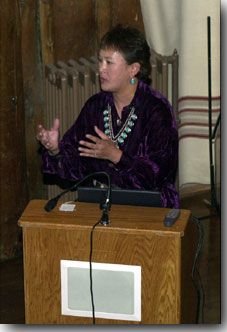 Dr. Lori Arviso-Alvord, associate dean for student and minority affairs at Dartmouth Medical School, spoke on the importance of affirmative action and the Navajo culture Tuesday at Fuller Lodge in Los Alamos. The first Navajo woman surgeon, Arviso-Alvord's talk was sponsored by the Office of Equal Opportunity (OEO) and the New Mexico EEO and Diversity Council. She also is one of the keynote speakers at the 18th annual Equal Opportunity Diversity Training and Awareness seminar this week in Albuquerque.
Dr. Lori Arviso-Alvord, associate dean for student and minority affairs at Dartmouth Medical School, spoke on the importance of affirmative action and the Navajo culture Tuesday at Fuller Lodge in Los Alamos. The first Navajo woman surgeon, Arviso-Alvord's talk was sponsored by the Office of Equal Opportunity (OEO) and the New Mexico EEO and Diversity Council. She also is one of the keynote speakers at the 18th annual Equal Opportunity Diversity Training and Awareness seminar this week in Albuquerque."Navajos always mention their clan name first, my father's mother's clan is Tsi'naa-jinii, the black-streaked wood clan; his father's clan is Ashiihi Dineé, the salt clan," said Dr. Lori Arviso-Alvord, the first Navajo Woman surgeon, associate dean for student and minority affairs at Dartmouth Medical School and assistant professor of surgery. Arviso-Alvord spoke at Fuller Lodge on Tuesday.
Arviso-Alvord said she finds it surreal to come home to New Mexico, recalling that when she was a little girl, she would run on the mesas near her home on the reservation in Crownpoint, east of Farmington and Gallup. Later, when she first started lecturing, she said it didn't occur to her that her work would have ties to equal employment opportunity. I tried to create a different kind of medicine and over time I realized that something extraordinary had come out of the ordinary, Arviso-Alvord said.
Arviso-Alvord's talk was sponsored by the Office of Equal Opportunity (OEO) and the New Mexico (EEO) and Diversity Council.
According to Arviso-Alvord her autobiography, "The Scalpel and the Silver Bear," relates her attempt to bring state-of-the-art skills to the Navajo culture, in which the removal of organs is strongly resisted. It became obvious to me that I was challenging the fact that the mainstream culture was not creating a way for me to combine the two approaches to medicine," she said. "Affirmative action is more than getting people of color to the upper echelon; it's about having our worlds accepted and included," she said.
Arviso-Alvord set the tone for her PowerPoint presentation by describing a night chant. A night chant is a nine-night healing ceremony performed for the sick in the dead of winter. Sand paintings are made and other blessings are performed, including dancing, prayers and the use of corn pollen placed on the sick person's body. "It is said, that there are more than 750 night chants that were a gift from the ancient holy people and that everyone who attends the ceremony benefits. In this belief system, religion and medicine are one in the same," she said.
"Ceremonies are very powerful and they help the patients return to harmony which assists in healing because the body's harmony is restored," she said.

A map illustrates how the Navajo Nation stretches throughout the Southwest. Arviso-Alvord noted that this map lacked communities and towns other than those belonging to the Native American tribes. Arviso-Alvord used slides with her talk to help explain some of her cultural heritage. Photos by Michael Carlson, Public Affairs
Arviso-Alvord's presentation described in further detail "the blessing way," a traditional healing ceremony that she called a system approach to illness or wellness. "To fully understand the blessing way it's important to realize that everything in life is connected. We must learn to understand the bonds between humans, spirit and nature. Our illness and our healing alike come from maintaining strong and healthy relationships in every aspect of our lives," Arviso-Alvord explained.
The mind and its connection with science also is another model, she said. "Navajos believe that we can speak and think things into existence. We are taught that we should meditate on positive outcomes for the future. Chants have constant references to beauty for good relationships with all things," Arviso-Alvord said. "We believe that ill thoughts can cause harm, and research supports that positive thinkers live longer and healthier lives," she added.
The spirituality model depicts that all winds move through us while enhancing families and communities, she said. "Other things, such as animals and the environment are important and have a sacred component in the indigenous peoples' belief systems. Mother earth, father sky are revered and are protected and defended because of the balance between the environment and the resources," Arviso-Alvord said.
If the Navajo metaphors would be applied to the use of natural resources, Americans would do better. In the last 50 years the United States has consumed more resources than other countries combined and one day we won't be able to keep consuming, Arviso-Alvord said. There are cities that have such dirty air that people with respiratory problems can't breath, lakes where polychlorinated biphenyl levels are so high that people can't swim in them. Why is this so, she asked. Because of the lack of spirituality with the natural resources, she said.
"The [Native American] ceremonies talk a lot about sustainability, which means buy less, keep what we love, conserve energy and energy alternatives, recycle, be aware that genetically modified organisms are dangerous and protect and honor the animals," Arviso-Alvord said.
